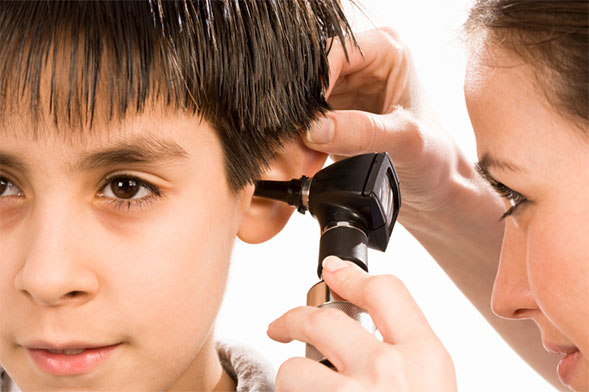Sounds for Sore Ears
SDSU's audiology program is the only professional doctoral program of its kind in California.

Housed within the Speech Language and Hearing Sciences building, located at the front of campus at Campanile Walkway, is a graduate program that has been humbly maintaining national status for nearly 60 years.
Clinical Audiology defined
The Doctoral Program in Audiology (AuD), offered jointly by San Diego State University and University of California, San Diego, is intended for students who are looking to specialize, practice and meet professional standards required to become a certified audiologist.
“It is the entry level degree for clinicians who want to practice audiology anywhere in the country,” said Steven Kramer, the director of the AuD program.
Faculty fromthe program bring a wide range of expertise from the School of Speech, Language and Hearing Sciences in the College of Health and Human Services at SDSU and from the Division of Surgery (Otolaryngology) in the School of Medicine at UCSD.
The partnership
Originally a master’s program, the audiology program transitioned nearly a decade ago to become a four-year doctoral program.
Faculty from SDSU collaborated with UCSD to design a program combining the resources and talent from the two campuses in order to create a cutting-edge program in clinical audiology.
Students have been enjoying the benefits of the successful structure — they engage in clinical experience throughout the entire four-year program.
“I came to tour SDSU during the audiology open house before I was accepted to the program. I loved how caring, involved and supportive the faculty was. I also loved the combination of a program between SDSU and UCSD,” said Kelsey Janet, a student in the AuD Program.
Janet is beginning her final year in the program with an externship at Rady Children’s Hospital beginning in June and hopes to work in a pediatric hospital after she completes the program in May of next year.
Successful structure
As the only professional doctoral audiology program in California, acceptance into the program is competitive and attracts highly qualified students. Potential students compete for nine to 10 spots in the program annually. Small classes allow students to work closely with each other and with their professors.
During the first and third year of the program, students take classes at SDSU and do clinical work either on campus or in the community. Their second year is spent learning and gaining more experience at UCSD.
“We have a full-blown clinical service here on SDSU’s campus, here in the SLHS building. Not a lot of people know that it is open to the community, students and faculty for full hearing evaluations and hearing aid fittings,” Kramer said.
The clinic gives students the opportunity to gain field experience on campus, maintaining easy access to guidance from the faculty and staff.
“The most valuable part of this program has been my clinical experiences. I have been able to do rotations at SDSU, UCSD, John Tracy Clinic in Los Angeles, Rady Children’s Hospital and the VA in San Diego," said Janet.
"This wide variety of placements allowed me to help find my interests in this growing and varied field. I love the hope our field brings to families and watching children with hearing loss succeed"
The final year of the program requires a full-time clinical externship at an approved agency anywhere in the country.
Maximizing the learning experience
The accredited doctoral program prides itself on maximizing the hands-on learning experiences of its students, which, according to Kramer, may have contributed to maintaining a top third ranking of clinical audiology programs in the country for several years now.
SDSU has sustained a high ranking in U.S. News and World Report and is currently ranked No. 27 in the country for its graduate audiology program.
“We put a lot of effort in the clinical skills in our students. We have a very systematic clinical experience track in which they learn skills as they are learning them in the classroom and they apply those skills. It progresses in terms of quantity of clinical experiences and the level of independence they achieve by the time they are ready for their externship,” Kramer said.
Each class of students individually gain about 800 hours of clinical experience prior to venturing into their last year in a full-time externship.
The experience helps these high-achieving graduate students reach a greater level of confidence in their skills, foster their passion for the field and develop an independence that carries them into their careers.
"My most memorable experiences have been with my classmates. There are only 10 students in my class and we all have become each other's biggest support system. I cannot wait to see where everyone ends up and all the advances each person brings to the field," Janet said.



